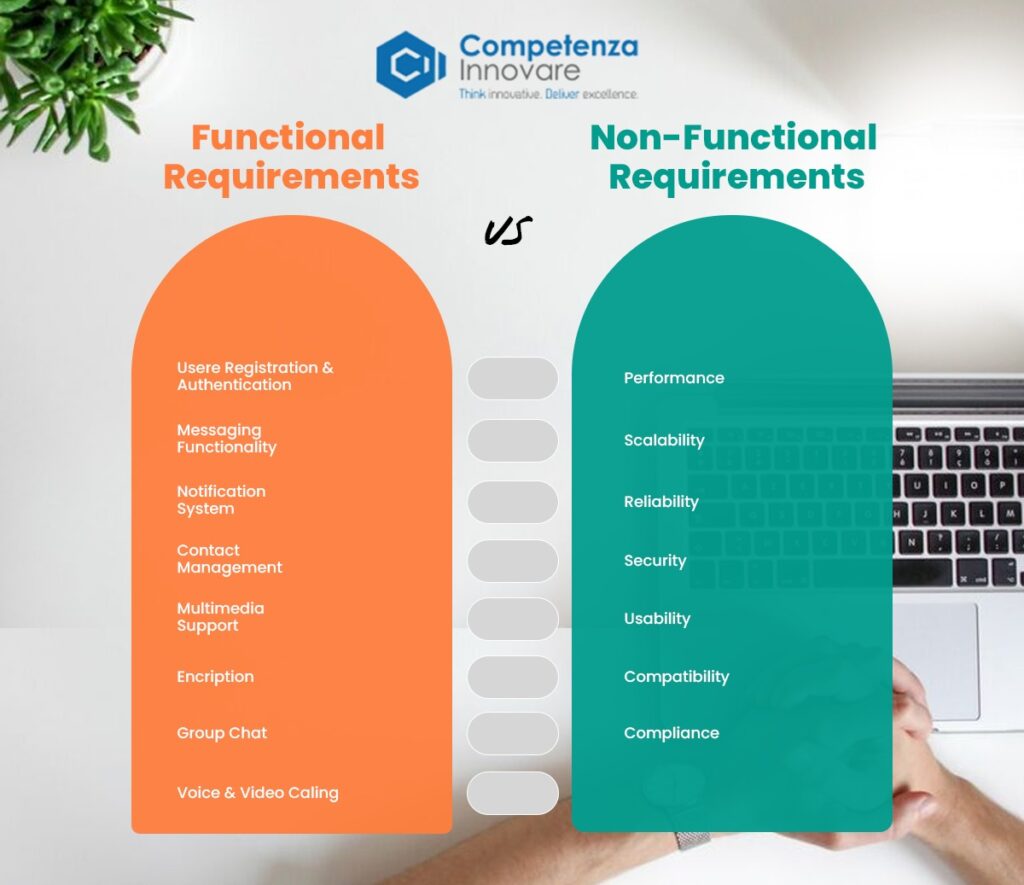To succeed in today’s fast-paced tech world, software projects must be able to distinguish between functional and non-functional requirements.
Join us as we delve into these essential pillars, revealing their impact on creating top-notch software solutions and their significance.
Functional Requirements
The functional requirements of a software system outline the features and functionalities that the system must have to facilitate user interactions. Our software is designed to provide users with intuitive and smooth experiences, and at Competenza Innovare, we focus on the thorough integration of these needs. Our offices are in Dubai, USA, and India.
Imagine a user interacting with a mobile app; crucial functional needs would include a simple account creation process, a secure login, and the ability to get real-time notifications. We enable users to browse our applications effortlessly by following these criteria, which fosters engagement and pleasure.
Nonfunctional Requirements
Nonfunctional requirements, on the other hand, specify the general standards of performance and reliability that an application must meet. Things like loading times, scalability, and conformity with regulatory standards are part of them, which go beyond simple functionalities.
Where user expectations are always changing—in the fast-paced digital environments, nonfunctional needs take center stage. Picture this: a payment gateway that puts security first without sacrificing performance, or a website that loads in seconds regardless of traffic. All of us here at Competenza Innovare hold these values in the highest regard.
Functional & Non-Funtional Requirements Example
Let’s explore functional and nonfunctional requirements in the context of developing a real-time messaging application, similar to WhatsApp or Telegram.

| Functional Requirements | Nonfunctional Requirements |
| User Registration and Authentication | Performance |
| Messaging Functionality | Scalability |
| Notification System | Reliability |
| Contact Management | Security |
| Multimedia Support | Usability |
| Encryption | Compatibility |
| Group Chat | Compliance |
| Voice and Video Calling |
Functional Requirements:
User Registration and Authentication: The ability to securely authenticate users and create accounts using phone numbers or email addresses is essential.
Messaging Functionality: Users should be able to send text messages, images, videos, and documents to individuals or groups in real time.
Notification System: Even when the app is closed or the device is locked, the user should still be notified promptly if new messages arrive.
Contact Management: The ability to manage one’s contacts, as well as locate and add new friends and contacts, should be readily available to users within the app.
Multimedia Support: You should be able to easily transmit and receive multimedia files, such as videos, photos, and documents, with this software.
Encryption: All communications should be encrypted end-to-end to ensure privacy and security for users’ conversations.
Group Chat: Users should be able to create groups, add or remove participants, and engage in group conversations.
Voice and Video Calling: The application should allow users to make voice and video calls to their contacts, both one-on-one and in groups.
Nonfunctional Requirements:
Performance: Messages should be delivered instantly, with minimal latency, even under high traffic conditions or in areas with poor network connectivity.
Scalability: The application should be able to handle a large number of users simultaneously without experiencing performance degradation.
Reliability: The messaging service should be highly reliable, with minimal downtime and the ability to recover quickly from failures.
Security: User data should be protected with robust encryption mechanisms to prevent unauthorized access or interception of messages.
Usability: The application should have an intuitive user interface, with easy navigation and clear feedback to users about the status of their messages.
Compatibility: The application should be compatible with a wide range of devices and operating systems, including smartphones, tablets, and desktop computers.
Compliance: The application should comply with relevant privacy regulations, such as GDPR or HIPAA, depending on the target market and user data handled.
In this example, functional requirements define the core features and capabilities of the messaging application, while nonfunctional requirements ensure that the application performs reliably, securely, and efficiently, providing users with a seamless and satisfying messaging experience.
Harmonizing Functionality and Performance for Optimal Results
In conclusion, our software solutions are built around functional and nonfunctional criteria. With these components in perfect harmony, we can build one-of-a-kind digital experiences that go beyond borders and improve people’s lives all across the globe.
Digital solutions that reshape industry norms are what we specialize in at Competenza Innovare, not merely software development. Come and be a part of this life-altering adventure with us, where we will push the boundaries of innovation and strive for greatness.
We hope that your answer to functional vs non-functional requirements is explained with proper examples. If you still need any help from our experts on the topic, please ask in the comment box.




